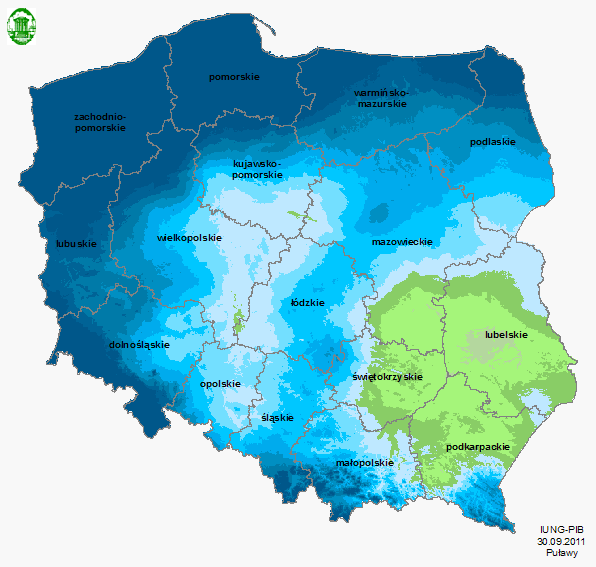ARCHIVES (2011)
Do roku 2016 raport oznaczony numerem 1 był tworzony za okres od 1 kwietnia do 31 maja. Od roku 2017 analizy są wykonywane o dekadę wcześniej czyli 1 raport oznacza okres od 21 marca do 20 maja
Communication report regarding the incidences of drought conditions in Poland
Year: 2011; period: 13 (1.VIII - 30.IX)
In the thirteenth reporting period i.e. from 1 August to 30 September 2011, we can find no threat of agricultural drought conditions in Poland.
In the thirteenth reporting period for the area of Poland, the average climatic water balance (CWB), relative to the previous period decreased by 57 mm. However, the value of CWB in Poland is still higher than the critical value. CWB values are positive only in Szczecin and the Koszalin Coastland, while the rest of the country they are negative. The lowest CWB values (from -120 to -159 mm) are present in the Lublin Uplands, Kielce and in the eastern part of the Sandomierz Valley as well as the Central Beskid Highlands.In August, it was warmest in central and southern Poland (18.5-19.5°C). The coldest was in the northern part of the country, from 17.5 to 18.5°C.
September was very warm throughout the country. The warmest was in the south-west of the country from 15 to 16°C. Colder was only in the north east of the country, the temperature in this area ranged from 13.5 to 14°C and was higher than the long-term average by about 1°C.
In August, the highest rainfall occurred in the north, the Coastland Koszalin, Zachodniopomorskie Lakeland, South Pomorskie and Mazurskie from 70 to 110 mm. The lowest rainfall occurred in south-east and east from 30 to 60 mm.
In September, the highest rainfall occurred north-west (from 60 to 100 mm) and western (from 30 to 60 mm) of the country. For the rest of the Poland, rainfall was much lower from 2 to 30 mm. Particularly low rainfall occurred in the Lublin region (from 2 to 15 mm).
Due to the occurring the thermal conditions in September, (high temperature) these should be regarded as favourable for crops. However, due to the humidity (very low rainfall), these were certainly not favourable for the emergence of winter crops.
Reports
- Report 13 (1.VIII - 30.IX)
- Report 12 (21.VII - 20.IX)
- Report 11 (11.VII - 10.IX)
- Report 10 (1.VII - 31.VIII)
- Report 09 (21.VI - 20.VIII)
- Report 08 (11.VI - 10.VIII)
- Report 07 (1.VI - 31.VII)
- Report 06 (21.V - 20.VII)
- Report 05 (11.V - 10.VII) +
- Report 04 (1.V - 30.VI) +
- Report 03 (21.IV - 20.VI) +
- Report 02 (11.IV - 10.VI) +
- Report 01 (1.IV - 31.V) +





